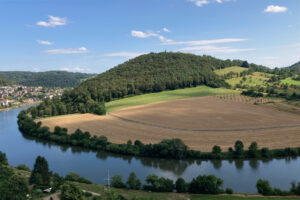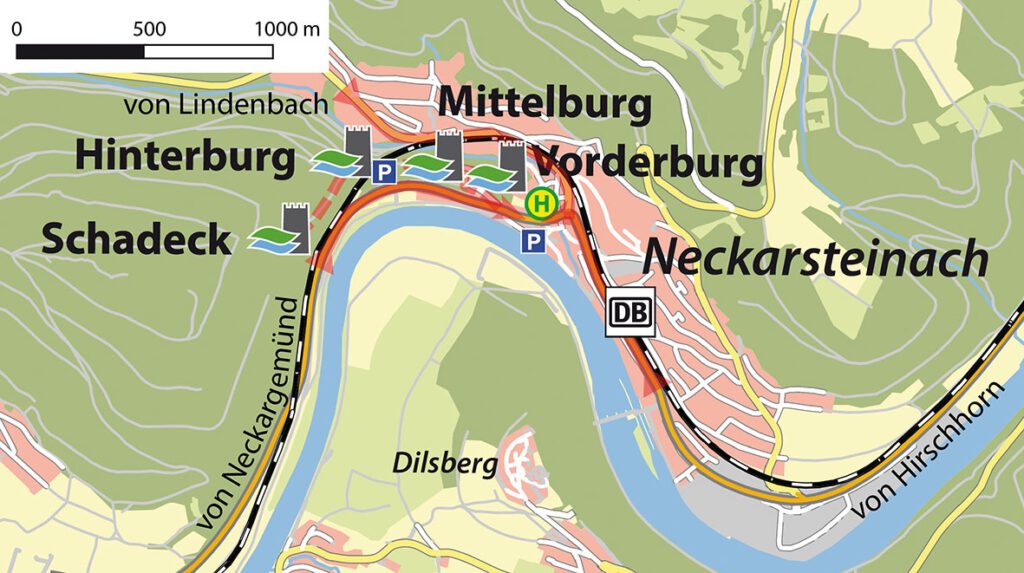
Neckarsteinach
Neckarsteinach is the southernmost town in Hessen and the southern entrance portal of the European Geo-Nature Park Bergstraße-Odenwald. Its most striking feature are the four medieval castles that rise like a wreath around the bend of the Neckar river. This four-castle ensemble, unique in Germany, the historic old town and, last but not least, the five-kilometre-long car-free promenade along the banks of the river give the town an unmistakable image.
The name of Neckarsteinach, which is embedded in a densely wooded mountainous landscape, originates from the Odenwaldbach Steinach stream flowing into the Neckar. The four fortifications, which gave Neckarsteinach the nickname “Vierburgenstadt” (four-castle town), were built between 1180 and 1260. All four castles were built by the knightly dynasty of the noblemen of Steinach, whose first name was “Bligger”. They and the place then called Steinach are first mentioned in a document from 1142. Bligger II is said to be the author of the Song of the Nibelungs. The Nibelungen Garden is a reminder of him and the 800-year-old, probably best known medieval epic.
Vorderburg
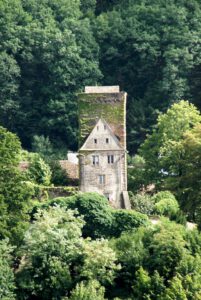 The historical starting point of the group of castles is the Vorderburg, which is situated above the old town and connected to the Neckarsteinach town wall. Around the castle there is a beautiful park with exotic trees. The castle complex is privately owned, is inhabited and cannot be visited. Although it does not appear in the documents until 1341, it probably already existed at the time when Neckarsteinach and the Steinach people were first mentioned in documents in 1142.
The historical starting point of the group of castles is the Vorderburg, which is situated above the old town and connected to the Neckarsteinach town wall. Around the castle there is a beautiful park with exotic trees. The castle complex is privately owned, is inhabited and cannot be visited. Although it does not appear in the documents until 1341, it probably already existed at the time when Neckarsteinach and the Steinach people were first mentioned in documents in 1142.
It remained in the feudal tenure of the lords of Steinach until their extinction in 1653. Around 1200, the minnesinger Bligger von Steinach lived within its walls, who is even assumed by some scholars to be the author of the Nibelungenlied.
Unfortunately, the building was reduced to the present, almost insignificant remains of keep and three storied great hall in the 18th century by continuous demolition. The still preserved town courtyard of the Lords of Steinach next to the church belonged to the front castle.
Mittelburg
The middle castle was probably built around 1200 in a topographically rather unfavorable location west of the front castle. The builders were probably the Counts of Lauffen – the feudal lords of the Steinach family.
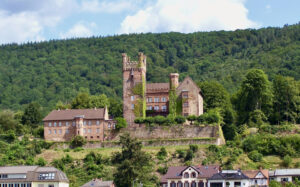 After a changeable fate, it came as a fief to the Landschaden von Steinach in 1551, who rebuilt it in the Renaissance style. The Neckar side of the castle now opened up in Renaissance arcades, while the medieval fortifications on the three other sides remained untouched. As the residence of the Landschaden von Steinach and their heirs, the middle castle survived the 17th and 18th centuries in the structural form described, only to fall victim to a neo-Gothic reconstruction in the period around 1835. The silhouette created at that time, which appears strange in the Neckar valley, is reminiscent of the castles rebuilt in the 19th century on the Middle Rhine.
After a changeable fate, it came as a fief to the Landschaden von Steinach in 1551, who rebuilt it in the Renaissance style. The Neckar side of the castle now opened up in Renaissance arcades, while the medieval fortifications on the three other sides remained untouched. As the residence of the Landschaden von Steinach and their heirs, the middle castle survived the 17th and 18th centuries in the structural form described, only to fall victim to a neo-Gothic reconstruction in the period around 1835. The silhouette created at that time, which appears strange in the Neckar valley, is reminiscent of the castles rebuilt in the 19th century on the Middle Rhine.
(Private property; viewing only possible with permission)
Hinterburg
Built around 1220/1230 – probably by Gerhard v. Schauenburg, one of the heirs of the Counts v. Lauffen, who died out in 1219 – the Hinterburg was built as a third castle.
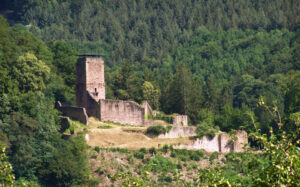 The construction of the Back Castle begun around 1100 at a strategically excellent location: The lord of the castle could monitor the Neckar Valley as well as the Steinachtal from here. It is the ancestral seat of the free nobles of Steinach, which they received as a fief of the Bishopric of Worms. Bligger of Steinach is mentioned as the lord of the castle from 1142 to 1165. His son, the minnesinger Bligger II. of Steinach extended the castle to an extensive Staufer castle around 1200.
The construction of the Back Castle begun around 1100 at a strategically excellent location: The lord of the castle could monitor the Neckar Valley as well as the Steinachtal from here. It is the ancestral seat of the free nobles of Steinach, which they received as a fief of the Bishopric of Worms. Bligger of Steinach is mentioned as the lord of the castle from 1142 to 1165. His son, the minnesinger Bligger II. of Steinach extended the castle to an extensive Staufer castle around 1200.
Since the Schauenburgs had overstretched themselves financially, the castle remained a ruin and was sold to Bishop Heinrich von Speyer around 1250. It was not until 1344 that Bishop Gerhard of Speyer started the final reconstruction of the still deserted castle and appointed a bailiff for it. The extension of its fortifications to form a triple ring of walls was carried out by order of the Speyer diocese between 1426 and 1450. The Hinterburg became a ruin around 1630 – during the Thirty Years’ War – but with its preserved building fabric it is today the most impressive of the four castles. Only the cellar vault of the great hall as well as an outer wall with Gothic arched windows are preserved. The complex, however, was repaired in such a way that numerous structural details such as beam holes and window struts, elements of a drawbridge and the old pavement of the castle courtyard can be seen. On the basis of the foundation walls plans of buildings and fortifications are visible.
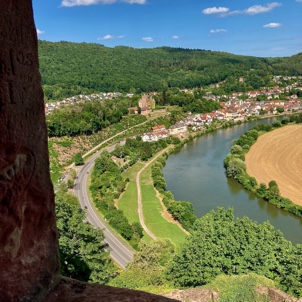 On the massive keep, which has a considerable area of eight by eight meters, a covered observation deck is located in 22 meters height. From here you have a wonderful view over the Neckar Valley, Neckarsteinach and the opposite Dilsberg. It’s a steep climb up the wooden staircase and a flashlight is advisable as there is no lighting inside the tower.
On the massive keep, which has a considerable area of eight by eight meters, a covered observation deck is located in 22 meters height. From here you have a wonderful view over the Neckar Valley, Neckarsteinach and the opposite Dilsberg. It’s a steep climb up the wooden staircase and a flashlight is advisable as there is no lighting inside the tower.
From 1272 the castle experiences an eventful history with phases of decay and phases of extension, however always with a frequent change of owners. In 1803 the complex was sold from the State of Hesse to the Lords of Dorth. But in 1910 the castle returned to the State of Hesse and can be visited at anytime.
Burg Schadeck – Schwalbennest
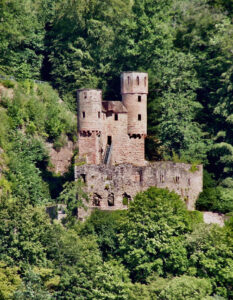 Schadeck Castle in Neckarsteinach is also called “Swallow’s Nest” because of its location on the steep slope above the Neckar River. The medieval ruin dating from 1335 is the youngest of the four Neckarsteinach castles.
Schadeck Castle in Neckarsteinach is also called “Swallow’s Nest” because of its location on the steep slope above the Neckar River. The medieval ruin dating from 1335 is the youngest of the four Neckarsteinach castles.
Schadeck Castle is the youngest and smallest, but also the most interesting of the four Neckarsteinach castles. The impressive ruin hangs on the high mountain like a bird’s nest and thus also called “Swallow’s Nest”.
Ulrich II inherited the “Vorderburg” from his father Ulrich I and another son entered the clerical state, so Bligger V, the third son, had to build a new castle. However, there was no more room for it on the ridge on which the other castles stood so it had to be built down the Neckar on the mountain massif that slopes steeply down to the river. Due to its location, its construction must have been extremely difficult. In order to obtain the space for the castle complex and to provide it with a neck ditch for protection against the mountain side, a large piece of the steep rock face had to be broken out. The castle itself stands on rocky ground and seems to almost grow out of the mountain. A covered walkway runs along the shield wall with turrets on both sides. A steep staircase from the inner courtyard affords access to the turrets, Allowing wide panoramic views over the Neckar valley and the Dilsberg.
The four castles are not too far apart, and thus the walks between them not too long. You can start the trail along the four castles in Neckarsteinach from different points. A recommended starting point is the Vierburgen parking lot, which is located below the Hinterburg just off the main road. The parking lot is free of charge and the climb up the zig-zag path to the Hinterburg takes just a few minutes.
Four Castles plan:
